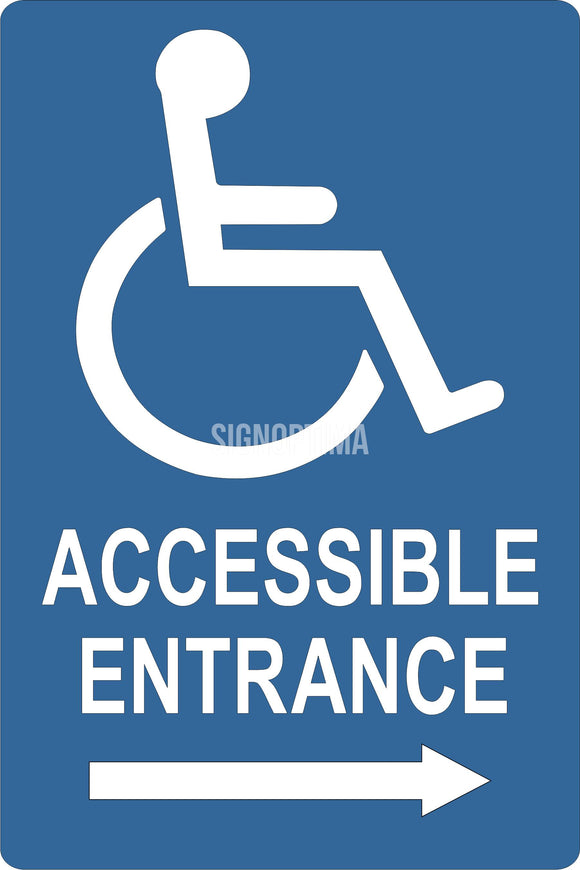The Impact of ADA Signs on Neighborhood Accessibility
The Impact of ADA Signs on Neighborhood Accessibility
Blog Article
Exploring the Secret Functions of ADA Indicators for Boosted Ease Of Access
In the realm of accessibility, ADA indications offer as silent yet effective allies, making sure that rooms are navigable and inclusive for people with specials needs. By integrating Braille and tactile aspects, these signs damage obstacles for the aesthetically impaired, while high-contrast color systems and legible typefaces cater to varied aesthetic requirements.
Importance of ADA Compliance
Making certain conformity with the Americans with Disabilities Act (ADA) is vital for cultivating inclusivity and equal accessibility in public spaces and offices. The ADA, established in 1990, mandates that all public facilities, companies, and transport services suit people with impairments, guaranteeing they appreciate the exact same civil liberties and opportunities as others. Compliance with ADA standards not just satisfies lawful obligations however also improves a company's online reputation by showing its commitment to diversity and inclusivity.
Among the essential elements of ADA compliance is the implementation of obtainable signs. ADA indicators are designed to ensure that individuals with specials needs can easily navigate with rooms and buildings. These indicators need to stick to particular standards relating to size, font, shade comparison, and positioning to guarantee exposure and readability for all. Effectively executed ADA signage helps get rid of barriers that people with impairments often experience, consequently advertising their independence and confidence (ADA Signs).
Moreover, sticking to ADA guidelines can alleviate the risk of legal consequences and possible fines. Organizations that stop working to follow ADA guidelines might face fines or suits, which can be both monetarily difficult and destructive to their public photo. Therefore, ADA conformity is integral to cultivating a fair environment for everybody.
Braille and Tactile Elements
The unification of Braille and tactile aspects right into ADA signage symbolizes the concepts of access and inclusivity. These attributes are important for people that are visually damaged or blind, enabling them to navigate public areas with higher self-reliance and confidence. Braille, a tactile writing system, is necessary in offering created details in a style that can be easily viewed through touch. It is normally positioned beneath the corresponding text on signage to make sure that people can access the info without aesthetic support.
Tactile elements prolong past Braille and include increased personalities and symbols. These elements are made to be discernible by touch, allowing individuals to recognize room numbers, toilets, departures, and various other important areas. The ADA sets particular standards concerning the size, spacing, and placement of these responsive aspects to maximize readability and ensure uniformity throughout various environments.

High-Contrast Color Design
High-contrast color pattern play an essential role in enhancing the exposure and readability of ADA signage for people with visual problems. These plans are important as they make the most of the distinction in light reflectance between text and background, making certain that indicators are quickly discernible, even from a distance. The Americans with Disabilities Act (ADA) mandates making use of details shade contrasts to suit those with minimal vision, making it a crucial facet of compliance.
The effectiveness of high-contrast colors lies in their ability to stand out in numerous lights problems, consisting of dimly lit settings and locations with glare. Commonly, dark message on a light background or light text on a dark background is utilized to accomplish ideal contrast. Black text on a white or yellow background offers a raw aesthetic distinction that assists in quick acknowledgment and understanding.

Legible Fonts and Text Size
When considering the layout of ADA signage, the selection of understandable font styles and proper text dimension can not be overemphasized. These aspects are vital for ensuring that indicators come to individuals with visual disabilities. The Americans with Disabilities Act (ADA) mandates that fonts need to be sans-serif and not italic, oblique, manuscript, highly attractive, or of uncommon kind. These requirements help make certain that the message is quickly legible from a distance and that the characters are distinct to diverse audiences.
According to ADA standards, the minimal message elevation need to be 5/8 inch, and it needs to enhance proportionally with seeing distance. Uniformity in text size adds to a natural visual experience, helping people in navigating atmospheres efficiently.
Furthermore, spacing between lines and letters is indispensable to legibility. Appropriate spacing avoids characters from showing up crowded, enhancing readability. By sticking to these standards, developers can dramatically boost ease of access, making certain that signage serves its desired purpose for all people, no matter their visual capabilities.
Reliable Placement Techniques
Strategic placement of ADA signage is essential for optimizing access and making certain compliance with legal requirements. Correctly positioned signs direct individuals with handicaps efficiently, facilitating navigation in public spaces. Key factors to consider include elevation, closeness, and presence. ADA standards stipulate that indications should be placed at an elevation between 48 to 60 inches from the ground to ensure they are within the line of view for both standing and seated people. This conventional height variety is essential for inclusivity, allowing mobility device users and people of varying heights to accessibility details effortlessly.
Furthermore, indications must be positioned nearby to the lock side of doors to permit easy recognition prior to entrance. Consistency in sign read placement throughout a facility boosts predictability, lowering complication and boosting general customer experience.

Verdict
ADA indicators play an essential duty in advertising ease of access by integrating features that deal with the demands of people with impairments. Integrating Braille and responsive aspects makes sure crucial info is obtainable to the visually damaged, while high-contrast color pattern and legible sans-serif typefaces boost visibility across different illumination problems. Reliable placement strategies, such as proper mounting elevations and tactical locations, better promote navigating. These elements collectively promote an inclusive atmosphere, underscoring the relevance of ADA compliance in ensuring equal access for all.
In the realm of availability, ADA signs serve as quiet yet effective allies, guaranteeing that spaces are navigable and inclusive for individuals with handicaps. The ADA, passed in 1990, mandates that all public facilities, companies, and transport services suit individuals with disabilities, ensuring they take pleasure in the very same rights and chances as others. ADA Signs. ADA indications are made to make certain that people with disabilities can quickly browse through structures and rooms. ADA guidelines specify that indications need to be installed at a height between 48 to 60 inches from the ground to guarantee they are within the line of sight for both standing and seated people.ADA signs play an essential role in promoting ease of access by incorporating functions that deal with the needs of people with handicaps
Report this page